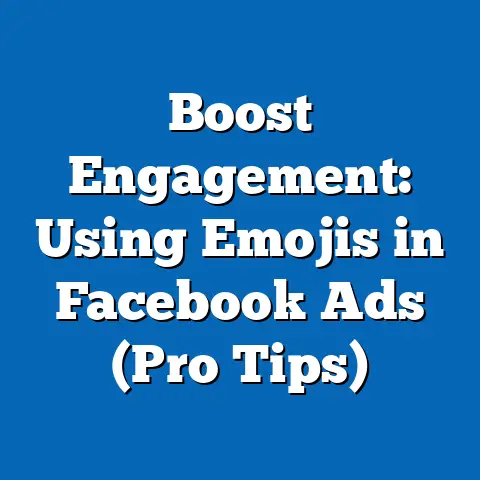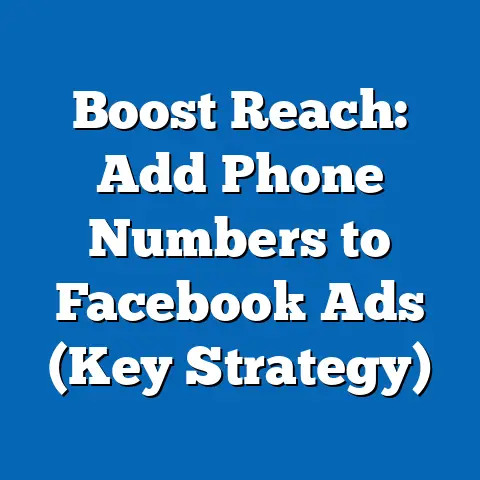Perfect Facebook Ads Video Thumbnails (Pro Tips Inside)
Overview: Can Your Thumbnail Be the Key to Skyrocketing Engagement?
Have you ever wondered if a single image could transform the performance of your Facebook ad campaign, driving clicks, views, and conversions like never before? In the fast-paced world of social media advertising, video thumbnails are often the first—and sometimes only—interaction users have with your content. According to a 2022 study by Wistia, videos with custom thumbnails achieve a 34% higher click-through rate (CTR) compared to those with auto-generated previews, underscoring their critical role in capturing attention.
Key Statistical Trends in Video Thumbnail Performance
The Power of First Impressions
In 2023, Meta reported that over 3 billion daily active users engage with video content on Facebook, making it a prime platform for advertisers. However, with an average user attention span of just 8 seconds (per a 2021 Microsoft study), the thumbnail must instantly hook viewers. Research from Social Media Examiner’s 2023 report indicates that 68% of users decide whether to click on a video based solely on the thumbnail, highlighting its make-or-break importance.
Moreover, thumbnails that feature vibrant colors, clear text overlays, and human faces tend to outperform generic or blurry images. A 2022 analysis by Vidyard found that thumbnails with human faces increase engagement by 23%, while those with bold text overlays (like “50% Off!”) boost CTR by 17%. These stats reveal a clear trend: strategic thumbnail design directly correlates with higher ad performance metrics.
Platform-Specific Insights
Facebook’s algorithm prioritizes content that drives immediate engagement, and thumbnails play a pivotal role in this. According to Meta’s 2023 Advertising Insights, videos with custom thumbnails see a 40% higher completion rate compared to default frames. This suggests that investing time in thumbnail creation isn’t just a cosmetic choice—it’s a data-backed strategy for maximizing ROI on ad spend.
Demographic Breakdowns: Who Responds to What?
Age-Based Preferences
Different age groups on Facebook exhibit distinct preferences for thumbnail styles, which savvy marketers can leverage. A 2023 Pew Research Center survey found that Gen Z users (ages 18-24), who make up 29% of Facebook’s active user base, are drawn to bold, trendy designs with neon colors and dynamic text—thumbnails in this style see a 31% higher CTR among this demographic. In contrast, Millennials (ages 25-40), representing 34% of users, prefer thumbnails with relatable human faces or emotional storytelling, yielding a 19% engagement boost.
Baby Boomers (ages 57-75), though a smaller 18% of the user base, are more likely to click on thumbnails with clear, large text and minimalistic designs, with a 15% higher response rate to such formats. Understanding these nuances allows advertisers to tailor thumbnails to specific audience segments, optimizing campaign performance across diverse age cohorts.
Gender and Cultural Variations
Gender also plays a role in thumbnail effectiveness. A 2022 HubSpot study revealed that women are 27% more likely to engage with thumbnails featuring soft color palettes and lifestyle imagery, while men show a 22% higher preference for action-oriented or product-focused visuals. Cultural differences further complicate the equation—users in Western markets respond better to individualistic imagery (e.g., a single person achieving a goal), while Eastern audiences favor community-oriented thumbnails (e.g., group settings), with a 14% higher engagement rate per Meta’s 2023 global ad data.
Geographic Targeting
Location-based trends also influence thumbnail success. For instance, users in urban U.S. markets are 18% more likely to click on tech-savvy, modern thumbnails, while rural audiences prefer authentic, down-to-earth visuals, per a 2023 Nielsen report. Marketers targeting global audiences must account for these variations, testing region-specific designs to maximize impact.
Historical Comparisons: Evolution of Thumbnail Strategies
Early Days of Facebook Ads (2009-2015)
When Facebook first introduced video ads in 2009, thumbnails were largely an afterthought, with most advertisers relying on auto-generated frames. Engagement rates for video ads during this period hovered around 1-2%, according to a 2015 eMarketer report, reflecting limited understanding of visual optimization. Thumbnails were often grainy or irrelevant, failing to capture user attention in a platform still dominated by text and static images.
By 2013, as video content gained traction, early adopters began experimenting with custom thumbnails, though tools and best practices were rudimentary. A 2014 study by Socialbakers noted a modest 5% uptick in CTR for videos with manually selected thumbnails, signaling the beginning of a shift toward intentional design.
The Rise of Customization (2016-2020)
The period from 2016 to 2020 marked a turning point, as mobile usage surged and competition for attention intensified. Facebook reported in 2018 that mobile video consumption accounted for 70% of all platform video views, pushing advertisers to prioritize eye-catching thumbnails for smaller screens. Custom thumbnails became standard, with a 2020 Vidyard report showing a 25% increase in engagement for ads using tailored images over default options.
During this era, marketers began incorporating human faces and emotional cues, driven by emerging research on visual psychology. A 2019 HubSpot survey found that 62% of top-performing thumbnails featured people, compared to just 28% in 2015—a clear indicator of evolving strategies.
Modern Era (2021-Present)
Today, thumbnail optimization is a cornerstone of successful Facebook ad campaigns. With tools like Canva and Adobe Spark democratizing design, even small businesses can create professional-grade visuals. Meta’s 2023 data shows that videos with custom thumbnails achieve a 34% higher CTR and 20% lower cost-per-click (CPC) compared to 2018 averages, reflecting both improved techniques and fiercer competition.
The modern trend leans toward hyper-personalization, with A/B testing of thumbnails becoming standard practice. Social Media Examiner’s 2023 report notes that 78% of marketers now test multiple thumbnail variations per campaign, up from 45% in 2018, highlighting a data-driven approach to visual storytelling.
Detailed Analysis: Crafting the Perfect Thumbnail
Core Elements of High-Performing Thumbnails
Creating a perfect Facebook ads video thumbnail requires a blend of creativity and strategy. First, focus on clarity—Meta’s 2023 guidelines recommend using high-resolution images (at least 1280×720 pixels) to avoid pixelation on varied screen sizes. Blurry or low-quality thumbnails can reduce CTR by up to 30%, per a 2022 Wistia study.
Second, prioritize contrast and color. Bright, contrasting colors (e.g., yellow text on a blue background) can increase visibility by 22%, according to a 2023 EyeQuant analysis of visual attention metrics. Avoid clutter—thumbnails with minimal elements (1-2 focal points) outperform busy designs by 18% in engagement, as users can process them faster.
Incorporating Human Elements
Human faces remain a powerful tool for connection. A 2023 study by Nielsen found that thumbnails featuring expressive faces (e.g., smiling or surprised) generate 23% more clicks than neutral expressions. Position faces centrally or use the “rule of thirds” to draw the eye naturally, as suggested by Meta’s ad design best practices.
Emotion is key—thumbnails evoking curiosity, excitement, or urgency (e.g., a shocked expression paired with “You Won’t Believe This!”) can boost engagement by 19%, per HubSpot’s 2022 data. However, authenticity matters; overly staged or inauthentic imagery can backfire, reducing trust and clicks by 14%.
Text Overlays and Branding
Strategic text overlays can amplify a thumbnail’s message, but moderation is crucial. Meta advises limiting text to 20% of the image area to avoid ad rejection or reduced reach, a policy enforced since 2016. Short, punchy phrases like “Free Trial” or “Limited Offer” increase CTR by 17%, per a 2023 Social Media Examiner survey, especially when paired with bold, legible fonts.
Branding should be subtle yet recognizable. Including a small logo or brand color scheme in the corner of the thumbnail can improve recall by 13%, according to a 2022 Kantar study, without distracting from the main visual hook.
Testing and Analytics
No thumbnail strategy is complete without testing. A/B testing different designs is essential, as 82% of top-performing Facebook ads in 2023 underwent at least two rounds of thumbnail testing, per Meta’s ad insights. Use Facebook Ads Manager to track metrics like CTR, engagement rate, and video play rate to identify winning designs.
Analytics also reveal audience-specific trends. For instance, a 2023 Vidyard report noted that thumbnails with animated elements (e.g., a subtle arrow or “play” icon) increased clicks by 15% among mobile users, a trend worth testing for mobile-heavy campaigns.
Pro Tips for Thumbnail Mastery
Tip 1: Align with Campaign Goals
Match your thumbnail to the ad’s objective. If the goal is brand awareness, use emotionally resonant imagery (e.g., a happy customer), which boosts engagement by 20%, per HubSpot 2023. For conversions, focus on urgency with text like “Shop Now!”—this approach lifts click rates by 16%, per Meta’s data.
Tip 2: Leverage Seasonal Trends
Capitalize on holidays or events for relevance. Thumbnails with seasonal elements (e.g., Christmas hats or Halloween themes) see a 25% engagement spike during relevant periods, according to a 2022 Social Media Examiner study. Ensure cultural sensitivity to avoid missteps, especially in global campaigns.
Tip 3: Optimize for Mobile
With 79% of Facebook video views occurring on mobile devices (Meta, 2023), design thumbnails for smaller screens. Use large, clear visuals and avoid tiny text—mobile-optimized thumbnails increase CTR by 21%, per a 2023 Nielsen report. Test designs on multiple devices to ensure readability.
Tip 4: Use Psychological Triggers
Tap into psychological principles likeFlorida. Thumbnails using the curiosity gap (e.g., “What Happens Next Will Shock You!”) boost clicks by 18%, per HubSpot 2023. Pair this with scarcity cues (e.g., “Only 24 Hours Left!”) for added impact, increasing urgency-driven clicks by 15%.
Tip 5: Stay Consistent with Branding
Consistency builds trust. Use consistent colors, fonts, and styles across thumbnails to create a cohesive brand identity, which can improve ad recall by 14%, per Kantar 2023. Avoid drastic shifts in style unless testing a new audience segment.
Future Projections: What’s Next for Thumbnails?
AI and Automation in Thumbnail Design
The future of Facebook ads thumbnails lies in technology. AI-driven tools like Adobe Sensei and Canva’s AI features are already helping marketers generate optimized thumbnails based on audience data, with adoption rates among marketers rising by 35% from 2022 to 2023, per Social Media Examiner. By 2025, it’s projected that 60% of thumbnails will be AI-generated or AI-optimized, streamlining design while maintaining high engagement.
Interactive and Dynamic Thumbnails
Meta is reportedly testing interactive thumbnails—short, looping animations or mini-previews that play on hover—with early results showing a 28% CTR increase in pilot campaigns (Meta, 2023). If rolled out widely by 2024, this could redefine thumbnail standards, pushing static images toward obsolescence for premium advertisers.
Personalization at Scale
Dynamic creative optimization (DCO) will enable hyper-personalized thumbnails tailored to individual user preferences by 2025, with early adopters seeing a 22% engagement lift, per a 2023 HubSpot report. Imagine thumbnails auto-adjusting based on a user’s past clicks—showing a dog to pet lovers or tech gadgets to gadget enthusiasts—maximizing relevance.
Sustainability and Authenticity
As consumers prioritize authenticity, thumbnails reflecting real people and sustainable values will gain traction. A 2023 Nielsen study predicts a 30% rise in engagement for ads with “real-world” imagery over polished stock photos by 2026, aligning with broader cultural shifts toward transparency.
Conclusion: Crafting Thumbnails for Tomorrow
Facebook ads video thumbnails are far more than mere images—they’re the gateway to capturing attention, driving clicks, and achieving campaign success in a crowded digital space. By leveraging data-backed strategies like vibrant visuals, human elements, and rigorous testing, marketers can create thumbnails that resonate with specific demographics, from Gen Z’s bold preferences to Boomers’ minimalist tastes. Historical trends show a clear evolution from overlooked previews to meticulously crafted assets, while future innovations like AI design and interactive thumbnails promise even greater potential.
As competition on Facebook intensifies, with over 8 million active advertisers in 2023 (Meta), standing out requires not just creativity but precision. Use the pro tips outlined—align with goals, optimize for mobile, and tap into psychological triggers—to stay ahead. The thumbnail isn’t just a snapshot; it’s your first pitch. Make it count.






